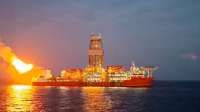Farhan said that China, in a separate letter, also protested against the predominantly land-based Garuda Shield military exercises in August, which took place during the standoff.
The exercises, involving 4,500 troops from the United States and Indonesia, have been a regular event since 2009. This was China's first protest against them, according to Farhan. "In their formal letter, the Chinese government was expressing their concern about the security stability in the area," he said.
Read Also: Asian factories shake off supply headaches but Omicron presents new risks
TENSIONS AT SEA
Within days of the Noble Clyde Boudreaux semi-submersible rig arriving at the Tuna Block in the Natuna Sea to drill two appraisal wells on June 30, a Chinese Coast Guard vessel was at the scene, according to ship movement data. It was soon joined by an Indonesian Coast Guard vessel.
In response to questions from Reuters, China's foreign ministry said the Chinese Coast Guard ship was "carrying out normal patrol activities in waters under Chinese jurisdiction." It did not respond to questions about communications with Indonesia over the drilling.
China's defence ministry did not respond to requests for comment.
Over the next four months, Chinese and Indonesian ships shadowed each other around the oil and gas field, frequently coming within 1 nautical mile of each other, according to an analysis of ship identification data and satellite imagery by the Asia Maritime Transparency Initiative (AMTI), a project run by the U.S.-based Center for Strategic and International Studies.
Data and images reviewed by AMTI and the Indonesia Ocean Justice Initiative (IOJI), a Jakarta-based independent think-tank, shows a Chinese research ship, Haiyang Dizhi 10, arrived in the area in late August, spending most of the next seven weeks moving slowly in a grid pattern of the adjacent D-Alpha Block, an oil and gas reserve also in contested waters, valued at $500 billion by Indonesian government studies.
"Based on the pattern of movement, nature, and ownership of the vessel, it looked like it was conducting a scientific survey of the D-Alpha reserve," said Jeremia Humolong, a researcher at the IOJI.
Read Also: Malaysia's palm giant FGV expects migrant workers to arrive by end-March
On Sept. 25, the American aircraft carrier USS Ronald Reagan came within 7 nautical miles of the Tuna Block drilling rig. "This is the first observed instance of a U.S. aircraft carrier operating in such proximity to an ongoing standoff" in the South China Sea, AMTI said in a report published in November.
Four Chinese warships were also deployed to the area, according to the IOJI and local fishermen.
A spokesman for the U.S. Navy's Carrier Strike Group 5/Task Force 70 declined to disclose the carrier's distance from the rig.
/2020/09/04/855139774p.jpg)








